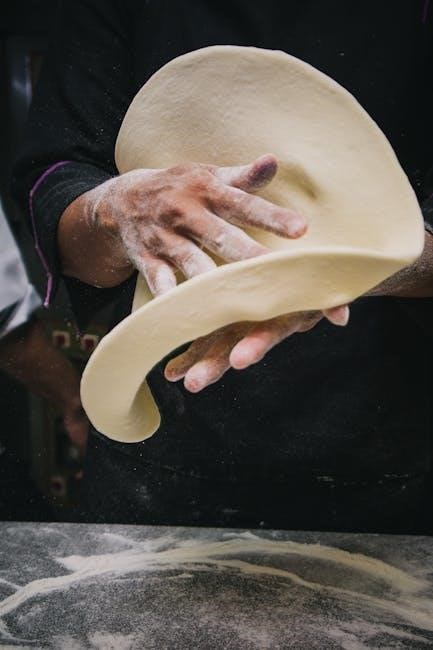Trader Joe’s Pizza Dough is a convenient and delicious solution for homemade pizza. It offers a quick way to create authentic, flavorful pies with minimal effort.
1.1 Overview of Trader Joe’s Pizza Dough
Trader Joe’s Pizza Dough is a popular choice for homemade pizza due to its convenience and quality. The dough is fresh, easy to work with, and offers a delicious base for your creations. It’s available in both regular and whole-wheat options, catering to different preferences. Many users praise its affordability and the fact that it saves time on making dough from scratch. The dough’s higher hydration level ensures a softer texture, but it can be cooked to a crispy crust with proper techniques. It’s a favorite for quick, flavorful meals.
1.2 Popularity and Convenience
Trader Joe’s Pizza Dough has gained immense popularity due to its unmatched convenience. Priced around $1.50, it’s an affordable alternative to homemade dough, saving time and effort. Many appreciate its pre-made format, eliminating the need for mixing and kneading. The dough’s versatility allows for various pizza styles, from thin crust to thick, making it a favorite for quick meals. Its widespread appeal lies in its ease of use and consistent results, perfect for both novice cooks and busy households seeking delicious, homemade pizza without the hassle.
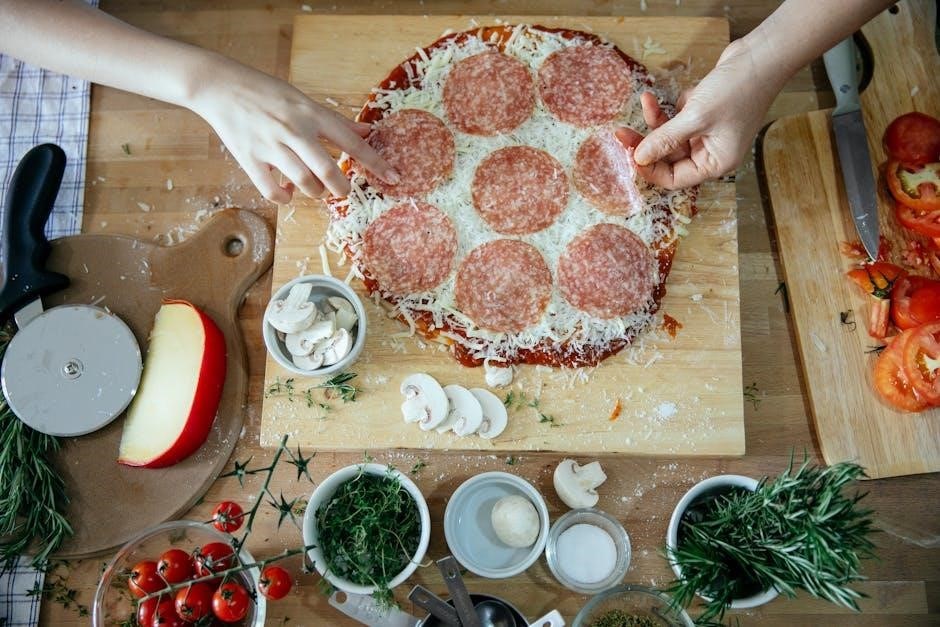
Key Ingredients and Tools Needed
Key ingredients include Trader Joe’s Pizza Dough, marinara sauce, cheese, and toppings. Essential tools are an oven, pizza stone, and rolling pin for preparation.
2.1 Ingredients Required
The essential ingredients for making pizza with Trader Joe’s dough include the dough itself, marinara sauce, mozzarella cheese, and your choice of toppings. Trader Joe’s Pizza Dough is the base, providing a fresh, high-hydrated texture. marinara sauce adds flavor, while mozzarella cheese ensures creaminess. Toppings can vary, such as vegetables (bell peppers, onions) or meats (pepperoni, sausage). Optional herbs like basil or oregano can enhance taste. This combination creates a delicious, customizable pizza with minimal effort and cost.
2.2 Essential Cooking Tools
To prepare Trader Joe’s Pizza Dough, you’ll need a few key tools. A preheated oven is crucial for baking, ideally with a pizza stone or baking sheet to ensure crispiness. A rolling pin helps shape the dough evenly, while a sharp knife or cutter aids in portioning. For grilling, a grill mat or oiled surface prevents sticking. Optional tools include a stand mixer for kneading or a pastry brush for oiling. These tools streamline the process, ensuring a perfectly cooked crust and evenly distributed toppings. Proper equipment enhances both convenience and results.
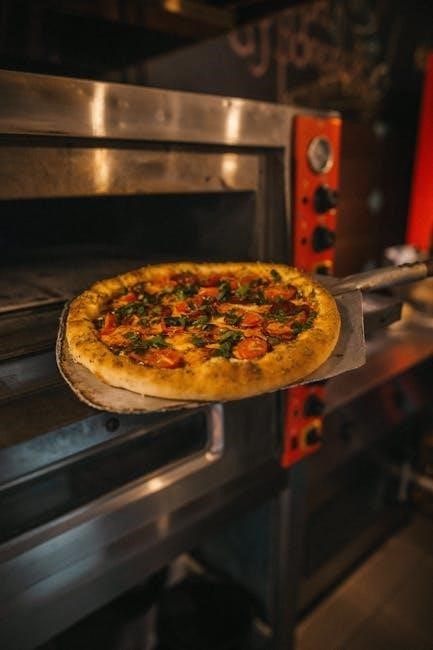
Preparation Steps
Preparing Trader Joe’s Pizza Dough involves thawing, rolling, and shaping. Thawing ensures pliability, while rolling and shaping create the desired form for toppings and cooking methods.
3.1 Thawing the Dough
Thawing Trader Joe’s Pizza Dough is essential for easy handling. Remove the dough from the freezer and let it thaw at room temperature for about 30 minutes. Alternatively, refrigerate overnight to thaw slowly. Ensure the dough reaches room temperature before rolling to maintain elasticity and prevent tearing. Proper thawing ensures the dough can be shaped and stretched smoothly, creating a uniform base for your pizza. This step is crucial for achieving the best texture and cooking results.
3.2 Rolling Out the Dough
Rolling out Trader Joe’s Pizza Dough ensures an even base for your pizza. Use a rolling pin to flatten the dough on a floured surface, aiming for your desired thickness. For a crispy crust, roll it thin, while a thicker roll suits a chewier texture. Transfer the dough to a preheated oven or grill surface. Ensure the dough is evenly stretched to maintain shape and avoid bubbles. Proper rolling ensures the dough cooks uniformly, delivering a delicious and well-textured crust for your toppings.
3.3 Shaping the Dough
Shaping Trader Joe’s Pizza Dough is a crucial step for achieving the perfect pizza. Start by letting the dough rest for a few minutes to relax the gluten. Use your hands or a rolling pin to gently shape it into your desired form, such as a circle, rectangle, or oval. For a more even shape, try tossing and spinning the dough. Ensure the dough is evenly thick to avoid sogginess in the center. Proper shaping ensures a balanced crust and a professional finish for your homemade pizza.
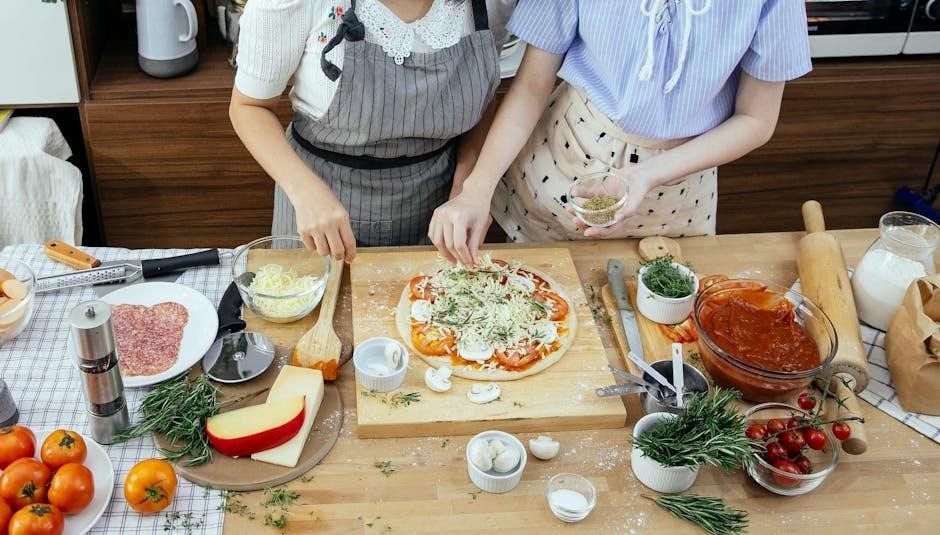
Oven Cooking Instructions
Preheat your oven to 450-475°F (232-245°C) for optimal cooking. Place the shaped dough on a baking sheet or pizza stone. Bake for 10-12 minutes until golden.
4.1 Preheating the Oven
Preheating the oven is essential for achieving a crispy crust. Set your oven to 450-475°F (232-245°C) and let it heat for at least 15-20 minutes. Using a pizza stone? Place it inside while preheating to ensure even heat distribution. A hot oven guarantees the dough cooks quickly, preventing sogginess. Proper preheating ensures the crust bakes evenly and becomes golden brown. This step is crucial for the perfect texture and flavor of your Trader Joe’s pizza.
4.2 Baking the Dough
Place the dough on a preheated pizza stone or baking sheet. Bake at 425-450°F for 10-12 minutes, or until the crust is golden and the cheese is bubbly. For a crisper crust, bake for an additional 2-3 minutes. Ensure even cooking by rotating the pizza halfway through. Avoid overloading with toppings to prevent sogginess. Let the pizza rest for a few minutes before slicing. This method ensures a perfectly cooked crust and evenly melted toppings.
4.3 Recommended Cooking Time
The recommended cooking time for Trader Joe’s Pizza Dough is 10-12 minutes in a preheated oven at 425-450°F. This ensures the crust is golden and the cheese is bubbly. For a crisper crust, bake for an additional 2-3 minutes. Thinner crusts may require 8-10 minutes, while thicker ones might need 12-14 minutes. Monitor the pizza during the last few minutes to avoid overcooking; Adjust time based on toppings and desired crispiness. Proper timing yields a perfectly cooked pizza every time.
4.4 Using a Pizza Stone
A pizza stone enhances the cooking experience by distributing heat evenly and crisping the crust. Preheat the stone in the oven for 10-15 minutes before baking. Lightly dust the stone with cornmeal to prevent sticking. Place the shaped dough on the preheated stone and bake for 10-12 minutes. The stone mimics a brick oven, producing a crispy, well-cooked crust. For best results, ensure the stone is hot before adding the dough. This method ensures a perfectly cooked pizza with a professional touch.
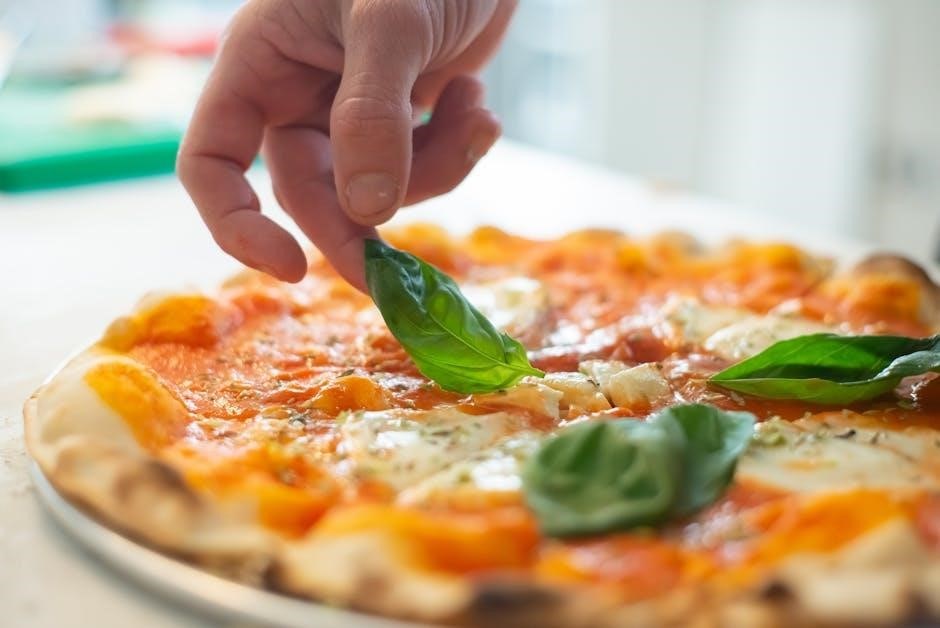
Grill Cooking Method
Grill cooking offers a smoky flavor. Preheat the grill, oil hands, and grill the dough first for a crispy base. Perfect for outdoor pizza nights.
5.1 Preparing the Grill
Preheat the grill to medium-high heat (around 450°F) to ensure even cooking. Clean the grates thoroughly and brush them lightly with oil to prevent sticking. If using a pizza stone, place it on the grill while preheating to absorb moisture and distribute heat evenly. Allow the grill to heat up for at least 10-15 minutes before cooking. This preparation ensures a crispy crust and a well-cooked base for your Trader Joe’s pizza dough.
5.2 Grilling the Dough
Once the grill is preheated, carefully place the Trader Joe’s pizza dough on the grates or pizza stone. Cook for 2-3 minutes on the first side, until the edges start to curl and the surface is dry. Flip the dough and cook for an additional 2-3 minutes, until golden brown. This method gives the crust a smoky, charred flavor. Keep an eye on the temperature to avoid burning, ensuring a perfectly grilled base for your toppings.
5.3 Adding Toppings on the Grill
After grilling one side of the dough, flip it and immediately add your preferred toppings. Spread a thin layer of marinara sauce, sprinkle cheese, and add toppings like pepperoni or vegetables. Close the grill lid to melt the cheese and heat the toppings. Cook for 2-3 minutes, until the cheese is bubbly and the toppings are heated through. Remove the pizza from the grill with a spatula and let it cool slightly before slicing. This method ensures a crispy crust with a flavorful, well-cooked topping combination.
Toppings and Sauces
Trader Joe’s Pizza Dough pairs perfectly with a variety of toppings and sauces. Use marinara sauce for a classic base, then add cheese, meats, and fresh vegetables.
6.1 Recommended Toppings
The choice of toppings can elevate your Trader Joe’s Pizza Dough creation. Classic options include a blend of cheeses like mozzarella, parmesan, and ricotta for creaminess. Fresh vegetables such as cherry tomatoes, spinach, and mushrooms add vibrant flavors. Cured meats like pepperoni, prosciutto, or Italian sausage provide a savory touch. For a seafood twist, shrimp or anchovies can be added. Vegan alternatives like roasted vegetables or plant-based cheeses are also great. Finish with fresh herbs like basil or oregano and a drizzle of olive oil for a well-rounded flavor profile.
6.2 Using Trader Joe’s Marinara Sauce
Trader Joe’s Marinara Sauce is a flavorful base for your pizza, offering a tangy and slightly sweet taste. Spread a thin layer evenly over the dough to avoid sogginess. Pair it with mozzarella cheese for a classic combination or mix with fresh toppings like cherry tomatoes or basil. The sauce complements both oven-baked and grilled pizzas, enhancing the overall flavor profile. Its convenience makes it a perfect addition to your homemade pizza creations.
6.3 Cheese Options
For a creamy and delicious pizza, mozzarella is the classic choice, melting perfectly and offering a mild flavor. Trader Joe’s also provides a variety of cheeses like provolone or gouda for unique twists. Blending mozzarella with Parmesan adds a sharp, savory note. Fresh or shredded cheeses work well, ensuring a smooth texture and rich taste. Experimenting with different combinations can elevate your pizza, making it a personalized culinary experience.
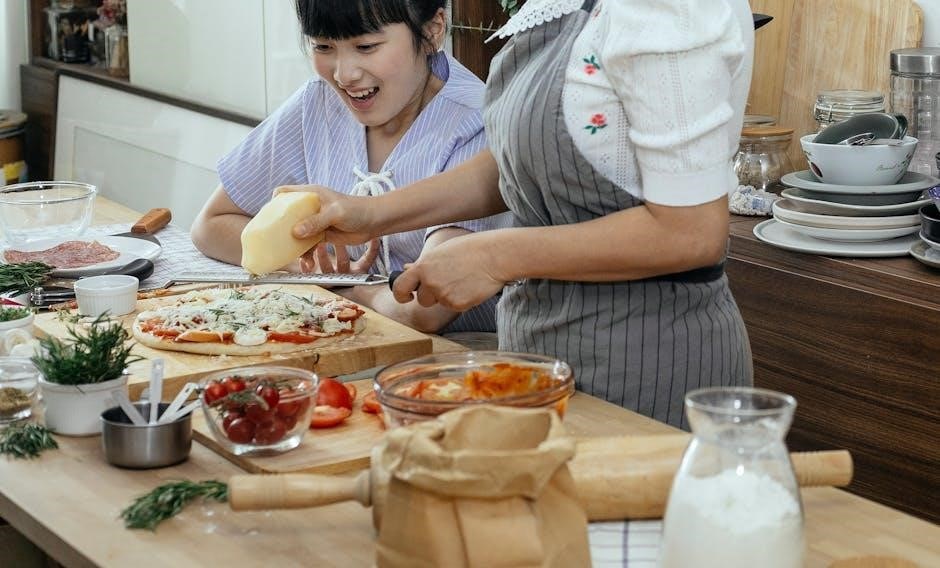
Tips for Achieving the Perfect Crust
Preheat the oven thoroughly and use a pizza stone for crispiness. Handle high-hydration dough gently to avoid sogginess. Don’t overwork the dough for the best texture.
7.1 Achieving Crispiness
To achieve a crispy crust, preheat your oven to a high temperature (around 475°F) and use a pizza stone. Roll the dough thin and bake for 1-2 minutes before adding toppings. This ensures the crust cooks evenly and becomes golden brown. Avoid overloading with toppings, as this can prevent the dough from crisping properly. Proper preheating and a well-seasoned stone are key to achieving that perfect, crunchy texture.
7.2 Handling High Hydration Dough
Trader Joe’s pizza dough has high hydration, making it soft and slightly sticky. To handle it effectively, lightly flour your hands and work surface. Gently roll or stretch the dough without overworking it, as this can lead to a dense crust. Use a dough scraper or oiled hands to manage stickiness. Letting the dough rest briefly after thawing can improve its texture and make it easier to shape. This ensures a smooth, even base for your pizza.
7.3 Preventing Sogginess
To prevent sogginess, ensure the oven is preheated to the correct temperature and use a pizza stone for even heat distribution. Avoid overloading the dough with toppings, as excess moisture can seep into the crust. Bake the pizza until the crust is golden and crispy, typically 10-12 minutes. Keep the dough thin and evenly spread to promote air circulation. These steps help achieve a crunchy base and avoid a soggy texture, ensuring a perfectly cooked pizza every time.
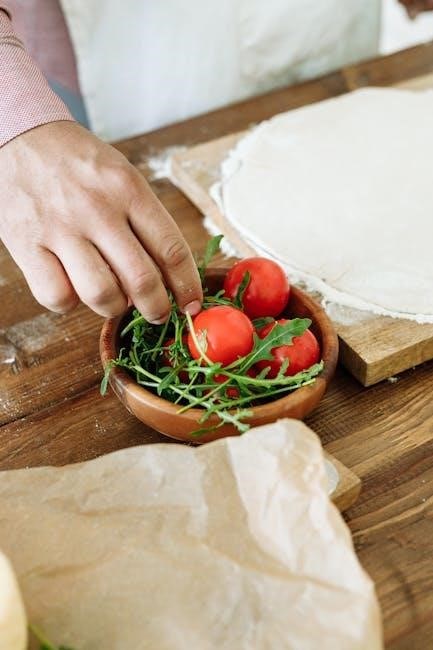
Common Mistakes to Avoid
Common mistakes include overworking the dough, using incorrect oven temperatures, and overloading with toppings, which can lead to a tough, burnt, or soggy crust.
8.1 Overworking the Dough
Overworking the dough can make it tough and dense, losing its natural elasticity. This often happens when the dough is rolled or stretched excessively. To prevent this, handle the dough gently, ensuring minimal stretching and rolling. Allow it to rest if it becomes too tight. Overworking also leads to a less airy texture, which can result in a crust that’s hard rather than crispy. Maintain a light touch to preserve the dough’s integrity and achieve the desired texture.
8.2 Incorrect Oven Temperature
Incorrect oven temperature can significantly affect the quality of your pizza. If the oven is too cool, the crust may not crisp properly, and the cheese won’t melt evenly. Conversely, an oven that’s too hot can burn the crust before the toppings are fully cooked. Preheating the oven to the recommended temperature (usually around 450°F) is essential for achieving a perfectly cooked pizza. Ensure your oven is fully preheated before baking, and consider using a pizza stone for even heat distribution. This step is crucial for a well-cooked crust.
8.3 Overloading with Toppings
Overloading your pizza with too many toppings can lead to a soggy crust and uneven cooking. Excess weight and moisture from toppings can make the dough struggle to crisp up. To avoid this, balance your toppings and avoid overly wet ingredients. A lighter hand ensures the crust cooks properly and maintains its texture. Pre-bake the dough slightly before adding toppings for extra support. This approach prevents sogginess and ensures a well-cooked, flavorful pizza every time.

Variations and Customization
Trader Joe’s Pizza Dough offers endless customization options. From classicMargherita to loaded meat-lovers, you can experiment with unique toppings, sauces, and cooking methods to create personalized pizzas.
9.1 Creating Different Pizza Styles
Trader Joe’s Pizza Dough is versatile for crafting various pizza styles. For a classic Neapolitan, keep it simple with marinara, mozzarella, and basil. Opt for a thin crust by rolling the dough thinly and baking at higher temperatures. For Chicago-style deep-dish, press dough into a deep pan and load with cheese, meats, and chunky sauce. To mimic New York-style, stretch the dough into a large circle and top with light sauce and mozzarella for a foldable slice. This dough adapts easily to your creative vision.
9.2 Vegan and Gluten-Free Options
Trader Joe’s Pizza Dough can be adapted for vegan and gluten-free diets. For vegan pizzas, use dairy-free cheese alternatives and load up on roasted vegetables. While the dough itself contains gluten, you can substitute it with gluten-free flours for a gluten-free version. Ensure all toppings are vegan and gluten-free to maintain dietary integrity. This versatility allows everyone to enjoy delicious homemade pizza, regardless of dietary restrictions.
9.3 Experimenting with Herbs and Spices
Elevate your pizza by experimenting with herbs and spices. Add oregano, basil, or garlic powder to the dough for extra flavor. Top with fresh herbs like rosemary or thyme for a fragrant twist. Spice blends like Italian seasoning or red pepper flakes can enhance the crust’s aroma. For a Mediterranean vibe, mix za’atar into the dough or sprinkle it on top. This customization allows you to create unique and flavorful pizzas that suit your taste preferences. Herbs and spices add depth without extra effort.
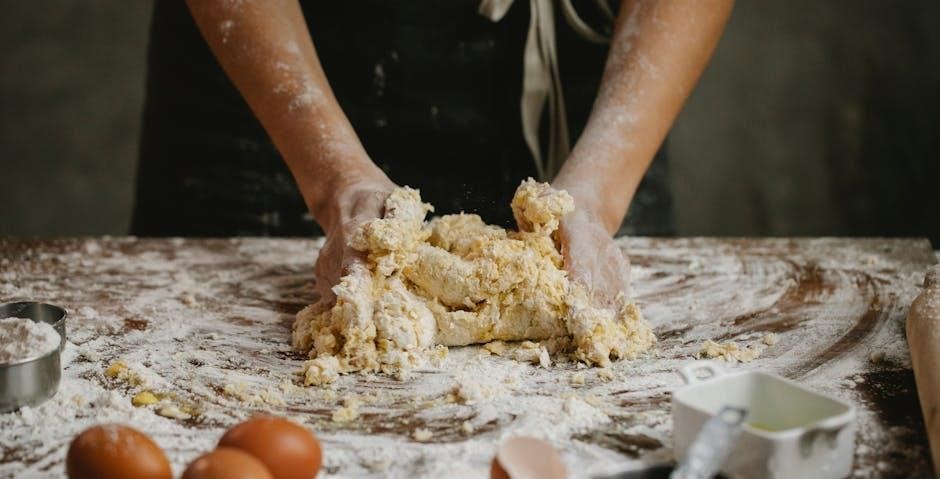
Storage and Reuse
Unused dough can be stored in an airtight container or plastic wrap in the fridge for up to 3-5 days or frozen for up to 3 months.
10.1 Storing Unused Dough
To store unused Trader Joe’s Pizza Dough, wrap it tightly in plastic wrap or place it in an airtight container. Store in the refrigerator for up to 3-5 days. For longer storage, wrap the dough in plastic wrap or aluminum foil and freeze for up to 3 months. When freezing, divide the dough into portions if you plan to use only part of it later. Before reusing, allow the dough to thaw in the refrigerator or at room temperature. Proper storage ensures the dough remains fresh and ready for future use.
10.2 Freezing the Dough
Freezing Trader Joe’s Pizza Dough is a convenient way to preserve it for future meals. Divide the dough into portions based on your needs. Wrap each portion tightly in plastic wrap or aluminum foil, ensuring no air exposure. Place the wrapped dough in a freezer-safe bag and store at 0°F (-18°C). Frozen dough can be kept for up to 3 months. When ready to use, thaw the dough in the refrigerator overnight or at room temperature for a few hours. This method maintains freshness and flexibility for later use.
10.4 Reusing Leftover Dough
Leftover Trader Joe’s Pizza Dough can be creatively repurposed, reducing waste and offering versatility. Use it to make garlic knots, breadsticks, or even as a base for appetizers. Roll the dough thin for crackers or thicker for a hearty flatbread. You can also refrigerate or freeze leftover dough for future meals, ensuring it remains fresh and ready to use. This flexibility makes Trader Joe’s dough a valuable kitchen staple for a variety of culinary creations.

Health and Nutritional Considerations
Trader Joe’s Pizza Dough is a treat best enjoyed in moderation due to its carb content. Pair it with nutrient-rich toppings for a balanced meal.
11.1 Nutritional Information
Trader Joe’s Pizza Dough is an affordable option at around $1.50, offering great value for homemade pizza. It contains wheat flour, water, yeast, and salt, with no preservatives. The whole wheat version provides more fiber for health-conscious users. The dough has higher hydration, which can affect cooking time and crust texture. Each serving typically contains approximately 120-150 calories, depending on portion size. For a balanced meal, pair it with fresh vegetables and lean proteins.
11.2 Healthier Topping Choices
To make your Trader Joe’s Pizza Dough creation healthier, opt for nutrient-rich toppings. Load up on colorful vegetables like spinach, mushrooms, bell peppers, and olives for added fiber and vitamins. Choose lean proteins such as grilled chicken or turkey pepperoni to reduce sodium and saturated fat. Lightly sprinkle cheese or use a dairy-free alternative to keep calories in check. Herbs and spices can enhance flavor without adding extra salt or sugar, making your pizza both delicious and balanced.
11.3 Calorie Count
Trader Joe’s Pizza Dough is a convenient base for homemade pizza, typically containing around 120-150 calories per 1/4 of the dough. To keep your pizza low-calorie, opt for lighter toppings like fresh vegetables, lean proteins, and herbs. Avoid excessive cheese or heavy meats to maintain a balanced meal. Pair your pizza with a side salad for a nutritious and satisfying dinner. Always check the nutrition label for exact values and consider portion sizes to align with your dietary goals.
Trader Joe’s Pizza Dough offers a quick and delicious way to make homemade pizza with minimal effort. Perfect for a satisfying meal any day.
12.1 Final Tips for Perfect Results
For the best results with Trader Joe’s Pizza Dough, preheat your oven thoroughly and roll the dough thin for a crispy crust. Avoid overloading with toppings to ensure even cooking. Use a pizza stone if available to enhance crispiness. Allow the dough to thaw and rest as instructed to achieve the perfect texture. Experiment with different toppings and cooking methods, like grilling, to create your ideal pizza.
12.2 Enjoying Your Homemade Pizza
There’s nothing quite like the satisfaction of enjoying a homemade pizza made with Trader Joe’s Pizza Dough. Share it with family and friends or savor it yourself—each bite offers a delicious reward for your efforts. Experiment with various toppings and cooking methods to find your perfect combination. Whether grilled or oven-baked, the result is a flavorful, satisfying meal that brings everyone together. Take pride in your creation and enjoy the joy of homemade pizza, tailored to your taste preferences.
